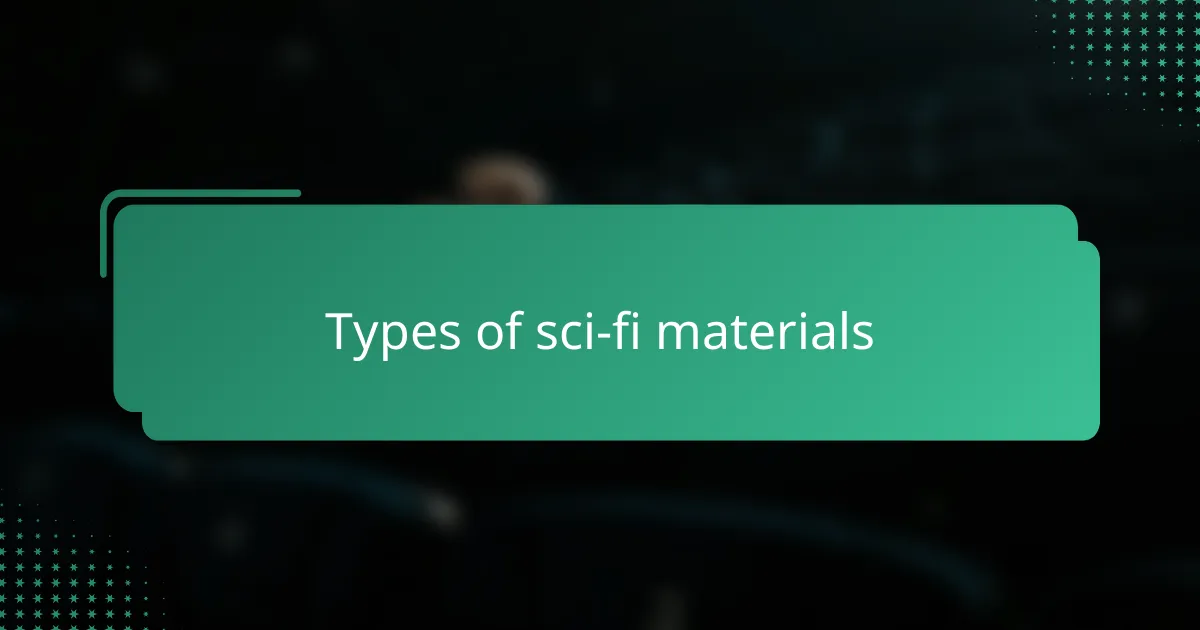Key takeaways
- Science fiction props serve as gateways to imaginative worlds, reflecting their stories and the characters that use them.
- Sourcing unique materials often involves exploring unexpected places and leveraging community connections for inspiration and insights.
- The quality of materials is critical; assessing texture, durability, and versatility can greatly impact the believability and functionality of a prop.
- Creative sourcing and testing under various conditions help ensure that the selected materials suit both the aesthetic and practical needs of the prop.

Understanding science fiction props
Science fiction props are more than just objects; they are tiny gateways into imaginative worlds. When I first held a replica laser pistol, I felt a rush of excitement—it was like touching the future, even if just for a moment. Don’t you think that’s what makes these items so captivating?
From my experience, understanding the purpose behind a prop adds layers to its appeal. Is it a tool, a weapon, or a symbol? Each prop tells a story, reflecting the universe it belongs to and the characters who rely on it.
I’ve often found myself lost in thought, wondering how designers balance originality with functionality. How do they predict what will feel believable in a world that doesn’t exist yet? This curiosity drives my appreciation for every intricate detail in sci-fi props.

Types of sci-fi materials
When I first started sourcing sci-fi materials, I quickly noticed they come in all sorts of forms—metallic alloys that gleam like something from the future, flexible polymers that mimic alien skin, and even translucent composites that seem almost otherworldly. It’s fascinating how these materials don’t just serve an aesthetic purpose but often suggest a technology or biology far beyond our current reach.
One thing that always intrigues me is how some materials carry an emotional weight. For instance, a prop made from rough, weathered metal instantly tells me a story of survival and battles fought in distant galaxies. Have you ever held a piece and felt that silent narrative whisper to you? That connection makes the sourcing process feel less like hunting and more like storytelling.
I’ve also been drawn to the clever use of light-reactive or sound-sensitive materials, which add a tactile dimension to the props. It makes me wonder—how much does a material’s responsiveness change our perception of the sci-fi world it belongs to? In my opinion, these subtle effects are what elevate a simple object into a piece of living imagination.

Sources for sci-fi materials
Finding reliable sources for sci-fi materials has always felt like embarking on a mini adventure for me. Sometimes, I stumble upon hidden gems in unexpected places like vintage stores or specialty craft shops, where a discarded piece of metal or an unusual plastic shape sparks immediate inspiration. Have you ever noticed how a simple, overlooked object can suddenly transform into a futuristic component with just a bit of imagination?
Of course, the internet has become an invaluable resource. I often dive into forums, supplier websites, and online marketplaces, hunting for cutting-edge materials or rare components. It’s amazing how a quick search can uncover alloys or polymers I never knew existed, opening up new possibilities for building props that look truly authentic.
But sometimes, nothing beats networking with fellow prop builders and makers. Sharing tips and trade secrets about where to source hard-to-find materials often leads me to suppliers I wouldn’t have discovered otherwise. Don’t you find that hearing someone else’s story about their sourcing journey adds a whole new layer of excitement to your own?

Evaluating material quality
When I evaluate the quality of sci-fi materials, I always start by feeling the texture and weight. Does it feel substantial or flimsy? A prop’s believability often hinges on this tangible reality—nothing pulls me out of a futuristic world faster than a material that feels cheap or fragile.
I’ve had moments where a piece looked perfect on the surface but failed the durability test during crafting. That experience taught me not to rely solely on appearance. Have you ever been excited by a shiny component only to realize it cracks under minimal pressure? That disappointment shaped how carefully I assess each material now.
Another aspect I value is consistency—whether the material behaves uniformly when cut, bent, or painted. In one project, I chose a polymer that twisted oddly under heat, ruining my design plan. It made me realize how crucial it is to understand a material’s limits before committing to it, sparing both time and frustration down the line.

Personal sourcing experiences
I remember the thrill of discovering an old, weathered piece of metal at a flea market that later became the cornerstone of a starship console prop. That moment taught me that the best materials often come from unexpected places, and trusting my intuition during sourcing can lead to truly unique results. Have you ever experienced that sudden spark when a simple find transforms your entire project?
Sometimes, the sourcing journey feels like piecing together a puzzle. I’ve spent hours comparing textures and colors online, only to realize the real test comes when the materials arrive in my hands—does the polymer flex just right? Is the finish convincing under studio lighting? It’s a delicate dance between digital discovery and tactile verification that keeps me engaged.
Networking has been a game-changer in my sourcing adventures. One time, a fellow prop enthusiast recommended a small supplier who specialized in futuristic fabrics, which I would have never found alone. Sharing these insider tips makes the whole process richer and reminds me that sourcing isn’t just about materials—it’s about the community behind the craft. Do you find that connecting with others opens doors you didn’t know existed?

Tips for sourcing sci-fi props
One thing I’ve learned is to always keep an open mind during the sourcing process. Have you ever picked up an ordinary item and suddenly imagined it as a futuristic gadget? Those spontaneous moments often lead to the most creative prop ideas. I find that being flexible allows me to discover materials that aren’t obviously sci-fi but become essential once transformed.
Another tip that’s served me well is to prioritize versatility when selecting materials. For example, a plastic that can be easily shaped or painted opens up countless possibilities. I remember struggling with a rigid component that just wouldn’t cooperate, and it taught me the hard way how critical material adaptability is. Don’t underestimate how much ease of manipulation affects your final result.
Lastly, I recommend tapping into multiple sourcing avenues simultaneously. Exploring online marketplaces, local craft stores, and even unexpected places like hardware shops can multiply your options. It’s like setting out on a treasure hunt—I once found a perfect metallic mesh in a gardening section that became an alien armor piece. Isn’t that thrill what makes prop sourcing truly exciting?

Best practices for material selection
I’ve found that choosing materials for sci-fi props isn’t just about looks—it’s about how a material feels and performs. When I first handled a lightweight metal alloy, it instantly convinced me of its futuristic authenticity. Have you ever noticed how the right weight or texture can make a prop feel genuinely believable in your hands?
Another practice I swear by is testing materials under different conditions before fully committing. I once picked a glossy plastic that looked incredible under showroom lights but dulled quickly with wear. That experience taught me the importance of durability and consistency—because no matter how stunning a material seems, it needs to keep up with the story it’s telling.
Finally, I always try to balance creativity with practicality. Sometimes, an unusual material sparks my imagination, like a flexible polymer that mimics alien skin, but I make sure it also suits the prop’s functional needs. Doesn’t it feel satisfying when you find that perfect match of aesthetics and usability? It’s those moments that transform a simple component into a memorable piece of sci-fi history.


